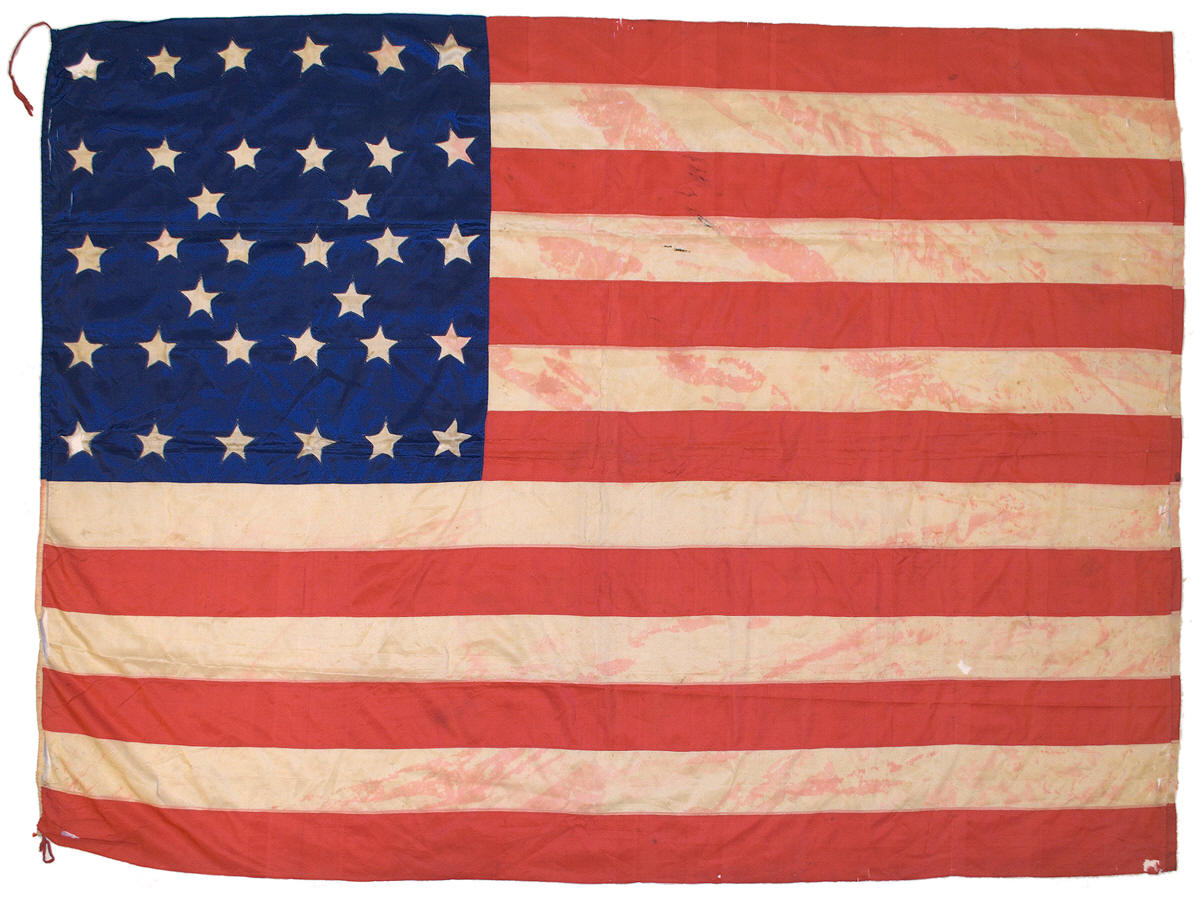
Although this flag has
not yet been attributed to a specific Union Army unit, the
size, format, construction and period of the flag are
all very strong indicators that the flag was made as a
Union presentation color, most likely for a Company
sized unit. The flag has qualities that are
strikingly similar to the Isaac Merry flag of Company A,
16th New York Volunteers, also in the Rare Flags
collection (IAS-00127).
This flag is made entirely of silk, which was by far the
most expensive and luxurious fabric of the day.
American flags were seldom made for personal or business
use in the era prior to the Civil War, but a flurry of
homemade flag making at the opening of the war ensued
when presentation colors were sewn by the women of
various communities and gifted to the leaders of the
forming units. Most that I have encountered were made at the
outset of the war, when units were outfitting themselves
ahead of receiving their official uniforms, weapons and
unit colors from their state governments. They
often feature 33 or, most typically, 34
stars as found on this flag. The flag's proportions, the use of a thin
silk sleeve hoist with silk rope, and silk stars are all
exemplary of the highest quality materials. The flag was made to present beautifully and to endure
prolonged use on the
battlefield.
This flag is entirely
hand sewn in an extremely fine stitch. It
took an extraordinary amount of time, talent and skill
to make this flag. The flag's silk stars are
single-appliqué, made using a single piece of silk with
the canton cut through in the shape of a star, enabling
each star to peek through to the opposite side. The
seamstress thoughtfully used a blue silk thread for the
outer seam of the star and a white silk thread for the
inner seam. She also used a
combination of white and red silk threads when sewing
the stripes and the turned-back fly end of the flag in order to mask the presence of the seams.
The pattern of 30 stars arranged in rows, with four
inliers, is unique in my experience. At first
glance, I believed that perhaps the flag was originally
30 stars, to which 4 additional stars were added, but
upon close inspection, it's evident that the star
material and stitching for the inner 4 stars matches all
of the other stars, and they were done at the same time
by the same hand.
The presence of the
rope hoist and some minor wear are evidence that the flag was
affixed to a staff and flown at some point, but it did
not endure significant wear and tear. While this
is purely conjecture, it's interesting to note that the
areas of pink bleeding from the red stripes into the
white are curiously slanted at an angle and appear in
bands. The bleeding is also heavier toward the top of the flag.
Just two of the stars shows indications of pink color
bleeding. This is a reasonable indication that the color bleeding
occurred when the flag was fairly new, was
hanging from it's flag staff and was subjected to rain.
If the commander of the unit noticed the bleeding, perhaps
he quickly retired the flag, thus preserving it in such
an excellent state. On
all counts, the flag itself is a rare and unique example
of a presentation color of the finest quality in terms
of materials and handiwork, and is a fine example of early
homemade flag-making from the opening years of the Civil
War.
The flag descended in
the family of the late actor John Beal. According to his
family, "he was born in 1909 and raised in Joplin,
MO. He then went on to have a long and full career in
Hollywood, New York, and t.v. First movie was with
Katherine Hepburn in The Little Minister, last one 60
years later with Tom Cruise in The Firm. More on him at
the IMDB website. His mother was raised in Dubuque in
the late 1800's. His grandfather, named Bliedung on his
paternal side, was originally from Germany. Left Germany
for the US because he didn't believe in German military
conscription. Ironically, he ended up joining the Union
forces in the Civil War. He may have been the one who
collected the flag." More research is required
to possibly determine if the flag did in fact belong to
the Civil War unit of John Beal's paternal grandfather.
|

